St. John US Virgin Islands: Your Travel Guide to One of the Last Slices of Paradise in the US
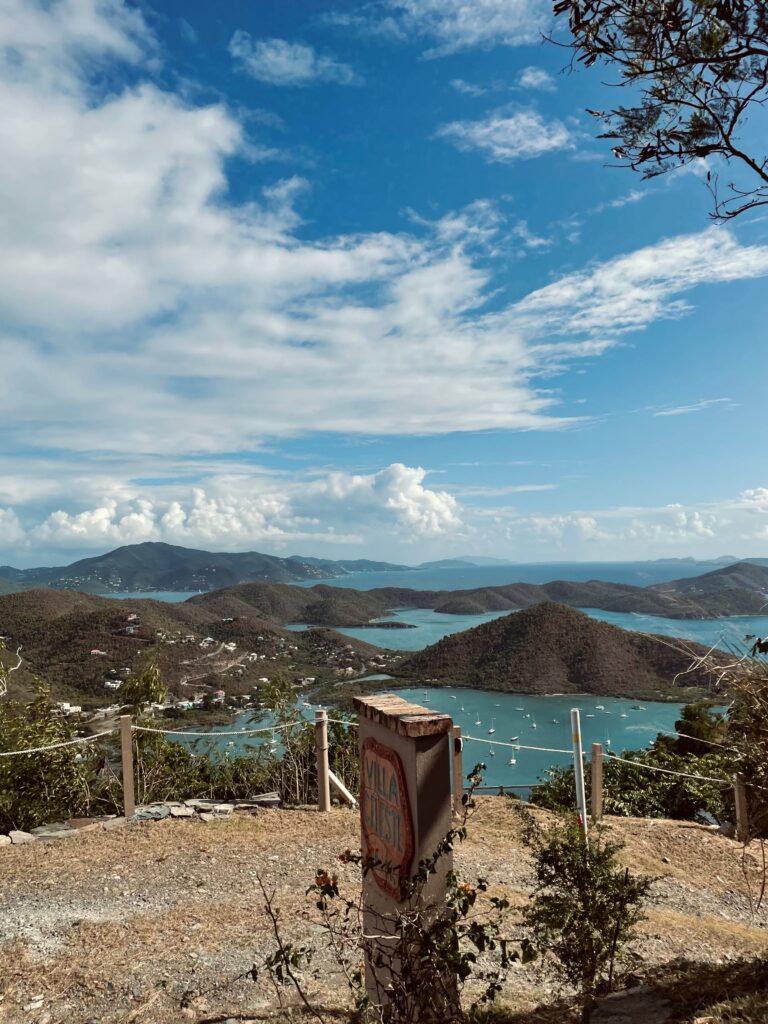
It was the winter of 2021 and we needed a little sunshine. But there was a catch…pandemic travel restrictions were still in place and we didn’t have many options. After some research and last-minute planning, we ended up in St. John, US Virgin Islands. It is probably not a place we would have normally considered, but after a few days, we quickly fell in love with the island. The world is large and there are many places to see, but we still think about going back.
St. John is the smallest, most rugged, and most rural of the three US Virgin Islands (St. Thomas and St. Croix). Because it lacks an airport and is nearly 60% national park, there are far fewer people. Picture white sandy beaches, warm waters, and amazing snorkeling without the crowds and typical tourist hawkers you will find in many destinations around the Caribbean.
Sounds amazing, right? If you are looking for a place where you can spend all day outside in nature, then you should make a trip out here. Just don’t forget to pack your snorkel mask and flippers. You might be lucky enough to spot a family of sea turtles before lunch! However, be prepared to navigate your 4X4 around steep mountain switchbacks to get there.
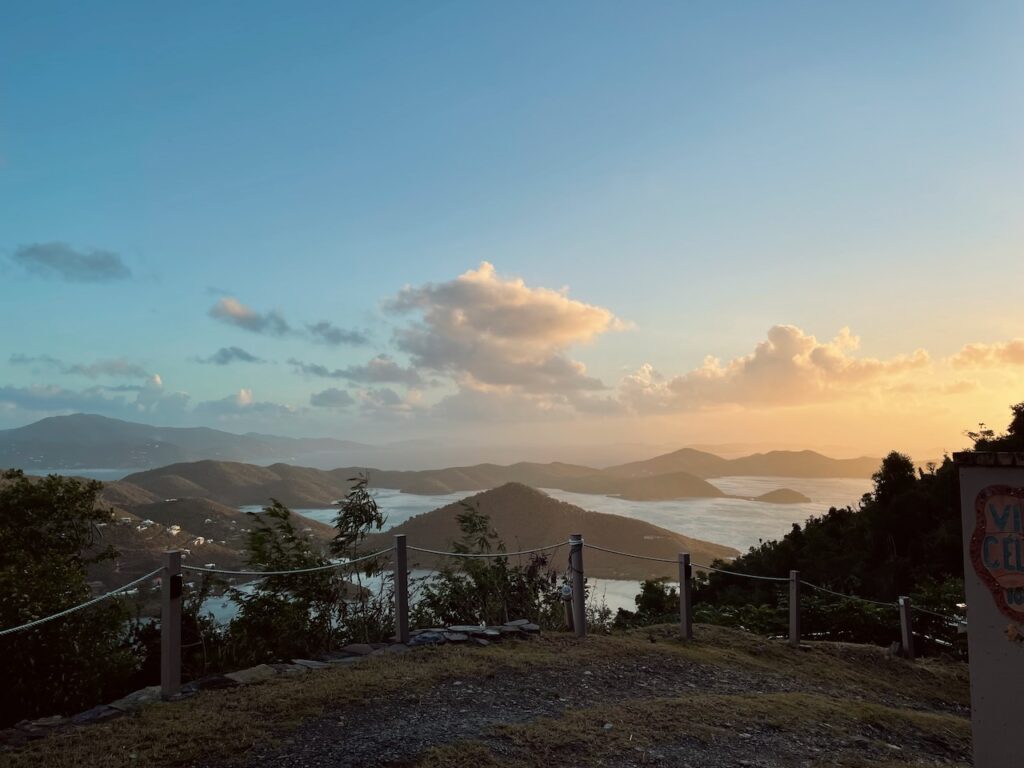
While we really enjoyed our time on the island, we should acknowledge that there may be better options if what you’re looking for a more culturally Caribbean experience. St John for better or worse is known as the suburbs of St. Thomas and has attracted lots of wealthy individuals who have built their second or third homes on the island. As a result, the island has become very “Americanized”. You can still experience St. John’s unique cultural blend, but you will just have to dig a little deeper.
Recommended Duration: 7-8 days
When to Visit: December to June. Skip July through October to avoid the rainy and hurricane season.
Getting Around: Driving, ideally a Jeep but at least 4WD!
Currency: USD ($)
Airport: Cyril E. King Airport (STT) with ferry to Cruz Bay
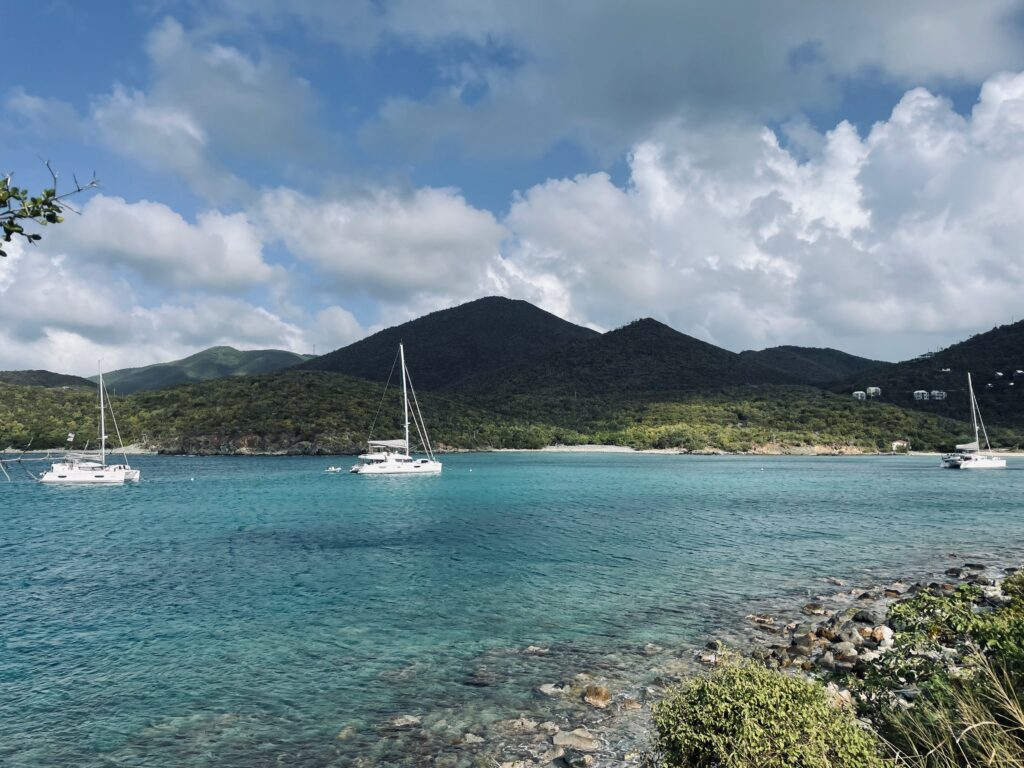
How to Get to St. John
We flew into Cyril E. King Airport (STT) and took a shuttle to Red Hook ferry terminal. You can check the shuttle schedule here. Our advice would be to get a car rental (preferably Jeep) at St. Thomas and drive to Red Hook to take the ferry to St. John. You’ll want a Jeep for St. John due to the roads being steep and windy.
Multiple ferries offer services from Red Hook (St. Thomas) to Cruz Bay (St. John). We recommend choosing the ferry with the best timing for your travel needs. We went with Love City Car Ferries as they were running the latest. When you’re booking your ferry, make sure to also book the return leg as well. This will guarantee you a spot! The ferries can get full and you don’t want to be stuck waiting and hoping to get on the next ferry with a flight to catch!
St. John or St. Thomas?
St. John has a more rugged feel than its sister, St. Thomas that we flew into. You can visit St. John as a day trip from nearby St. Thomas, but we think this would be a mistake. If what you want are beautiful beaches, fewer crowds, and more relaxed island life, then spend at least a week on St. John.
We completely skipped St. Thomas besides flying on and off the island and have no regrets. St. Thomas is a bustling cruise ship port and was not the island vibe we were looking for in a tropical vacation. Driving back across the island at the end of our trip only reinforced this feeling.
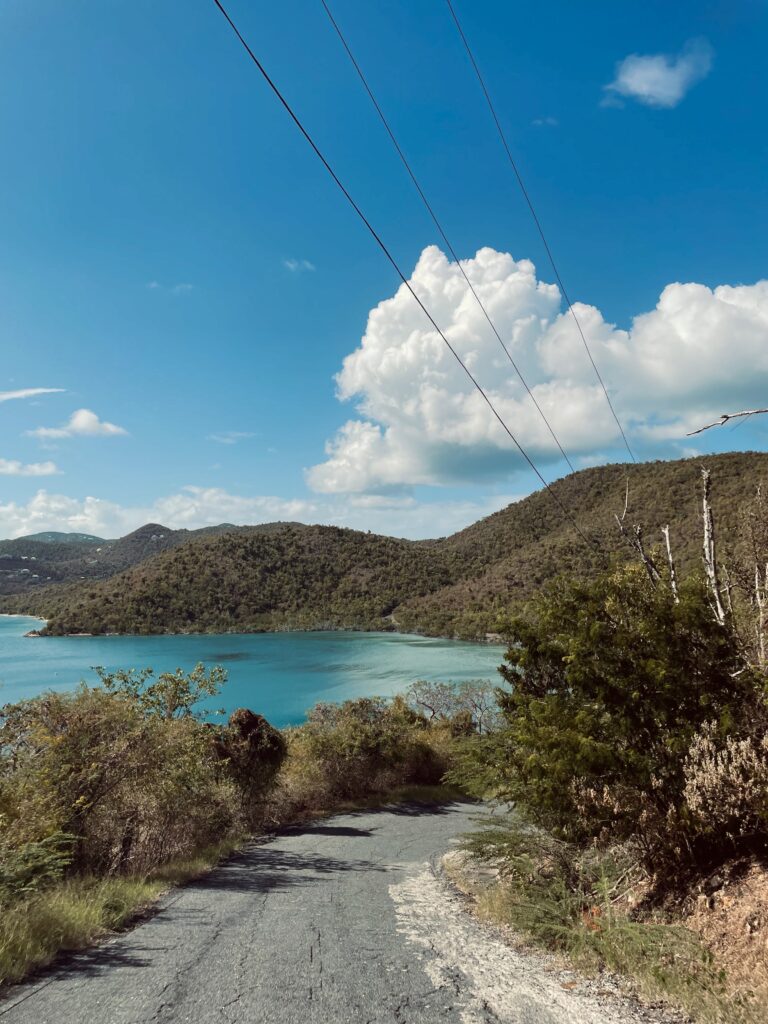
Cruz Bay or Coral Bay?
Ok, so you decided to stay in St. John. Where should you stay? You have two main options, Cruz Bay and Coral Bay. Cruz Bay is where you will arrive by ferry, and is home to the vast majority of restaurants, bars, and accommodations. However, we opted to stay on the opposite side of the island in Coral Bay. It is much quieter, less developed, and closer to many of the best beaches on the island.
It takes about 25 minutes to drive between Cruz Bay and Coral Bay, so we often stopped in Cruz Bay for supper at the end of a long day. Despite the drive, we would still recommend Coral Bay for those looking for an especially peaceful stay. However, if you want to walk to restaurants and hang out in the bars at night then make your life easy and stay in Cruz Bay.
Cruz Bay is also a better choice for more timid drivers, but more on that in the Driving section.
We ended up renting a tree fort-style cabin in Coral Bay, which was an amazing experience. To access our room we had to descend about 50 steps into the forest. At night we lay in bed listening to the surrounding wildlife as we fell asleep. It was certainly a memorable experience…and was also one of the more affordable options as we booked last minute. You can find that listing here.

Something that caught us by surprise was the amount of wild donkeys there were on the island, completely not bothered by all of the cars on the island. They walked as quickly as they liked and would find shady spots to get a break from the sun. We wouldn’t recommend touching these animals. Best to watch them from afar in case they decide they aren’t vibing with you.
Getting Around St. John
You will need a vehicle on St. John. There is a trolly that travels between Cruz Bay and some of the more popular beaches, which may be suitable for a day trip. But if you are spending more than a day or two you will need to rent a vehicle to truly experience all corners of the island. Some of our favorite spots, like Salt Pond Beach where we found a family of sea turtles, would have been inaccessible without a vehicle.
Note: There is also a public bus, but do not rely on this. The bus comes and goes by the beat of its own drum, schedules be damned. Which could leave you stranded for hours.
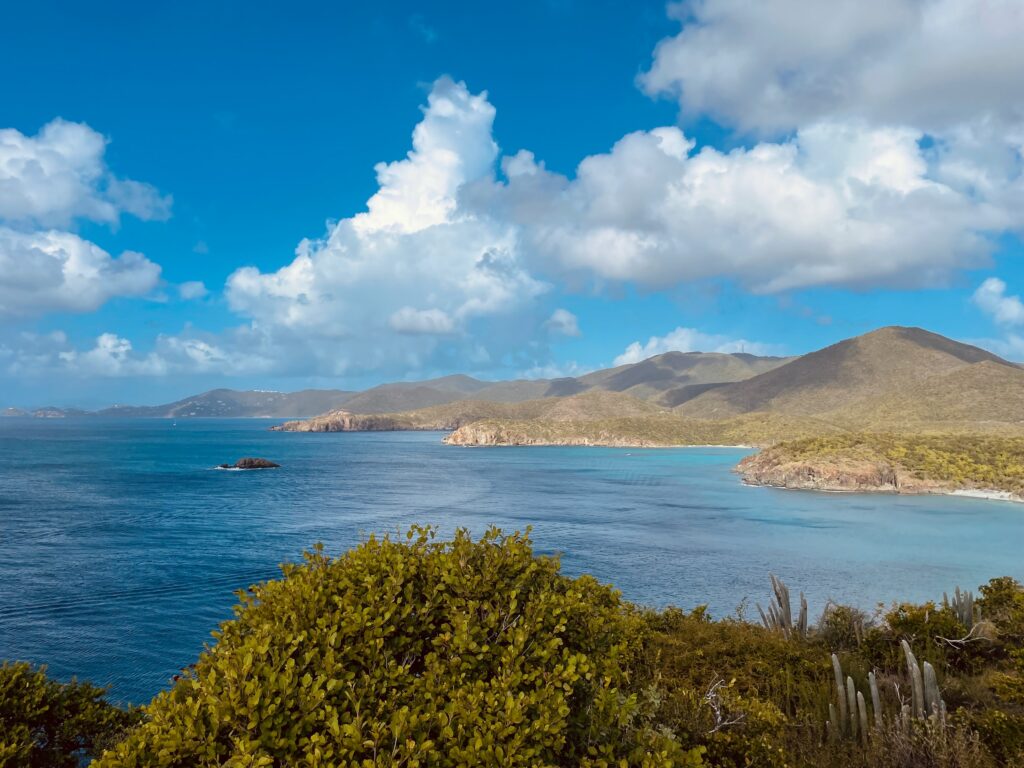
Renting a Vehicle
When it comes to renting a vehicle, make your life easy and just rent one in St. John. The only exception to this rule would be if you are spending a few days in St. Thomas and will already be renting a vehicle. In that case, you can rent on St. Thomas and take the car ferry instead of the main passenger ferry to St. John.
The reason for renting on St. John is that it removes unnecessary complications. We attempted to rent from Avis at the airport only to find out that they gave away our vehicle despite having already paid for it, leaving us scrambling to find a new rental once we landed. We ended up missing the last car ferry for the evening. Our lesson was twofold, don’t use Avis and just rent on St. John.
In terms of what to rent. Get a 4X4 off-road capable vehicle with decent ground clearance. Most rentals on the island are Jeeps, which will do you perfectly. Capable enough for the steep and windy roads and some unpaved sections, but also small enough to navigate Cruz Bay streets and parking. There are several decently reviewed rental companies, including Sunshine’s Jeep Rental and Courtesy Car and Jeep Rental.
Note: Car rental companies in the USVI tend to have stickers in the interior stating that you will be charged an extra cleaning fee of several hundred dollars for excessive sand. Strange for an island, but it is what it is. We don’t know what the threshold for excessive is, but just be mindful or find a gas station vacuum station before returning the vehicle.

Driving in St. John
Driving in St. John is a bit of an adjustment, to put it mildly. Roads are narrow, switchbacks are frequent, cliffside drop-offs are everywhere, and some roads are so steep you will need to put your jeep low to make the climb. Also. did we mention that you will be driving on the left side of the road in a left-hand drive vehicle? So watch out when making a corner that you end up on the proper side of the street.
It took a few days to adjust. The first couple nights do what we did and make sure to get back to your accommodation before dark as you become accustomed to the roads and traffic. But by day three, you will get the hang of it.
And watch out for donkeys. They are everywhere.
How Long to Spend in St. John?
We spent 8 nights on St. John and thought it was about perfect. If you want to do some day sailing or scuba diving, you could extend your trip. If you don’t love days on the beach or in the water you can stay only a few nights. Though let’s be honest, if this is you then you are looking at traveling to the wrong part of the world.
When is the Best Time to Visit St. John?
The best time to visit is December to June. This will avoid the July through October hurricane and rain season. We went in December and thought the weather was perfect. However, April through June will have fewer people and more affordable accommodations.

Is it Expensive?
Yes. There is no getting around this. Lower-end accommodations will be several hundred per night, and a basic burger and fries could run you over $30. Add on a vehicle rental and your week will put you at $3,500 at a minimum for two people before flights.
You can save costs by bringing some more expensive items with you from home. This includes meats and cheeses. Many travelers will put these in a cooler and carry them on the plane from the US mainland. Another option is stocking up at the grocery store in St. Thomas. There is a small grocery store on St. John, but the prices were pretty jaw-dropping. Still cheaper though to pick up a few snacks there for the beach than eating out for every meal.
Where to Eat in St. John
There are a few high-end restaurants on St. John located in Cruz Bay. However, just know that for those foodies out there St. John isn’t your kind of place. Most of what you will eat is fairly basic. Think fried seafood, burgers, and BBQ.
That said, there was one place on the island that stood out above the rest. Ekaete Pink Corner in Coral Bay offers incredible local Caribbean foods. The hours are a bit sporadic so check the door to know when to go back, it is definitely worth it!
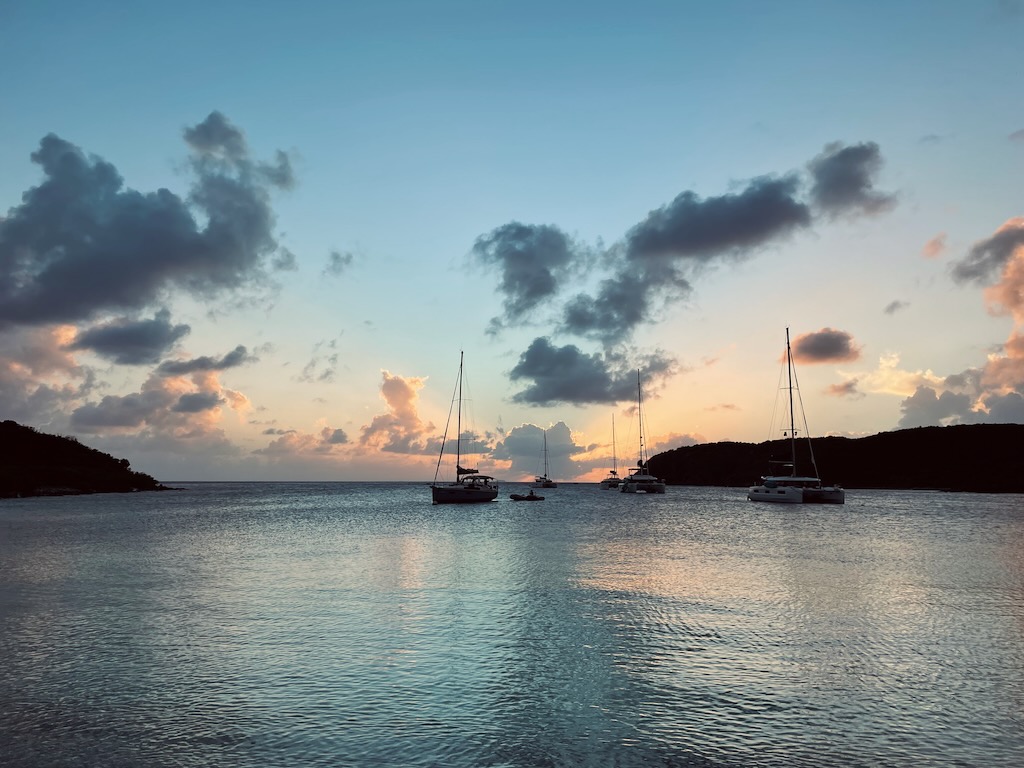
Notable Beaches
This is why you come to St. John. To enjoy the beaches and snorkel in the clear and warm waters. There are so many beaches around the Island that you could visit a few every day and still have some left over after a week. These are a few of our favorite stops, but there are many more worth visiting.
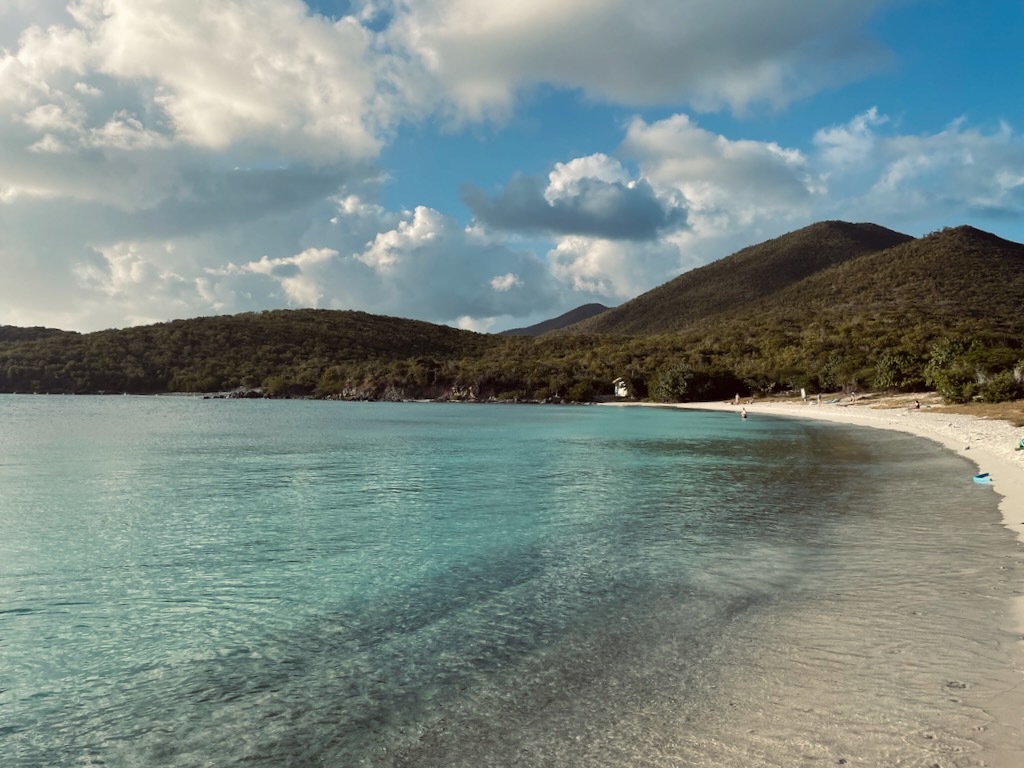
Salt Pond Beach
This was our absolute favorite beach. We went back here several times as parking was never a problem, there weren’t that many people around, it is a relatively sandy beach so we could lay, and most importantly… plentiful turtle sightings! There were days when we saw multiple baby sea turtles in the water! We give them plenty of space while swimming in the water.
The beach is a protected cove, so this is a great option for less confident swimmers. There are no bathrooms or restaurants so pack your own food and water.

Bonus Hike: There’s also a trail nearby, Ram Head Peak if you want to explore a bit. The trail isn’t difficult but there isn’t much shade available so make sure you water if you’re hiking this in the afternoon. The views are fantastic and you can always dip at the beach afterwards as a reward!
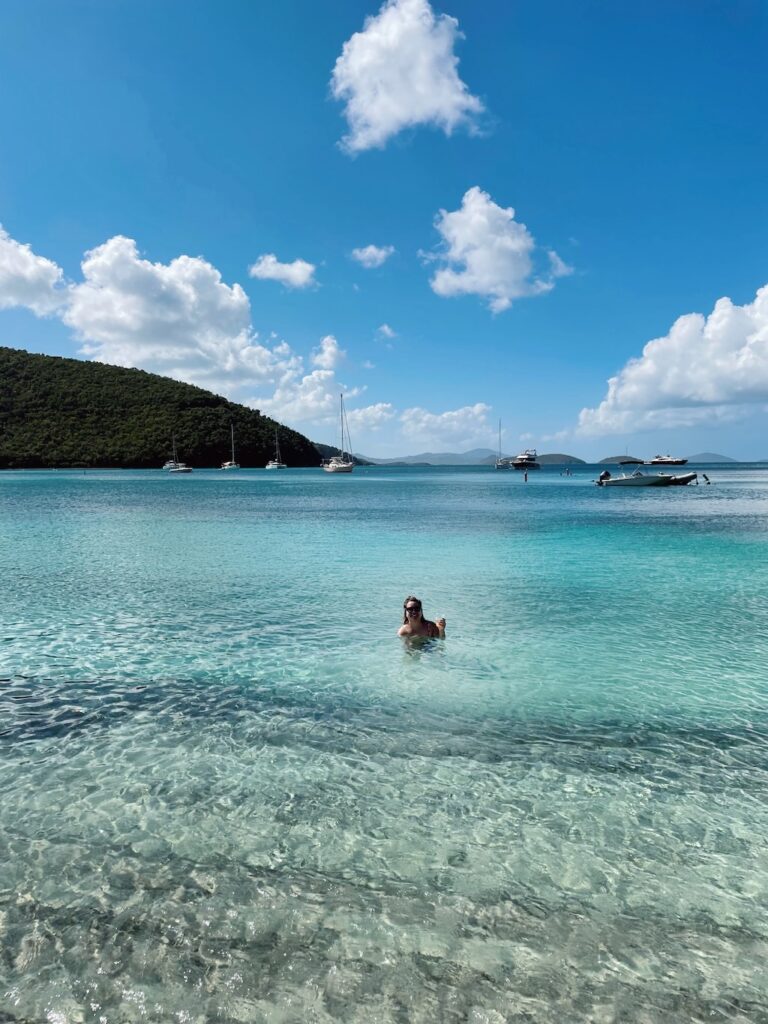
Maho Bay Beach
Maho Bay Beach was a close first. There’s a reason why this beach is so popular. The sand is amazing, the water is clear… and there’s a food truck across the street! You can easily hang out here all day and even rent paddleboards. Like Salt Pond Beach, there isn’t much shade here so be sure to bring an umbrella or hat if you plan on being out here all day. Due to its popularity, it can be difficult to find a parking spot so we recommend either coming early to stake out for the day or coming in the late afternoon. We did see a sea turtle here, but nothing compared to Salt Pond Beach.
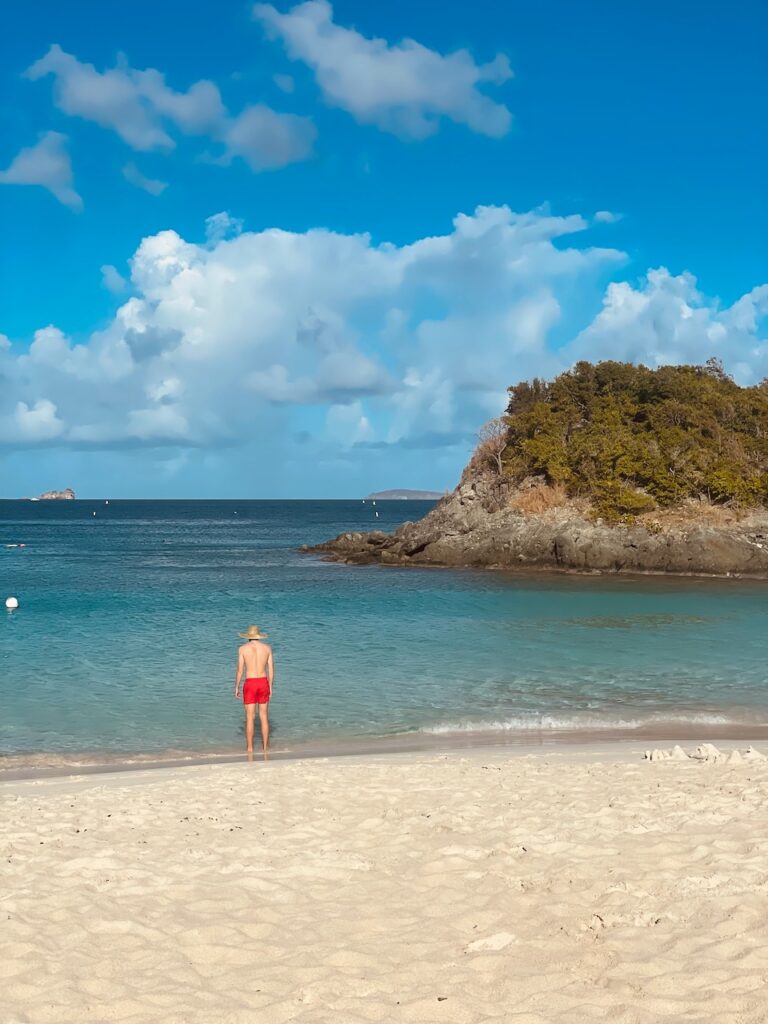
Trunk Bay
Trunk Bay is famous for a reason, with its crystal clear blue waters and underwater snorkeling trail, it’s a great spot for sunbathing and snorkeling. There is an entry fee of $5 per person and worth it. Unfortunately, it was super windy when we went, so we didn’t spend too much time at this beach once we finished snorkeling. You can access Trunk Bay by Trolly from Cruz Bay if you are visiting for the day and don’t have a vehicle.
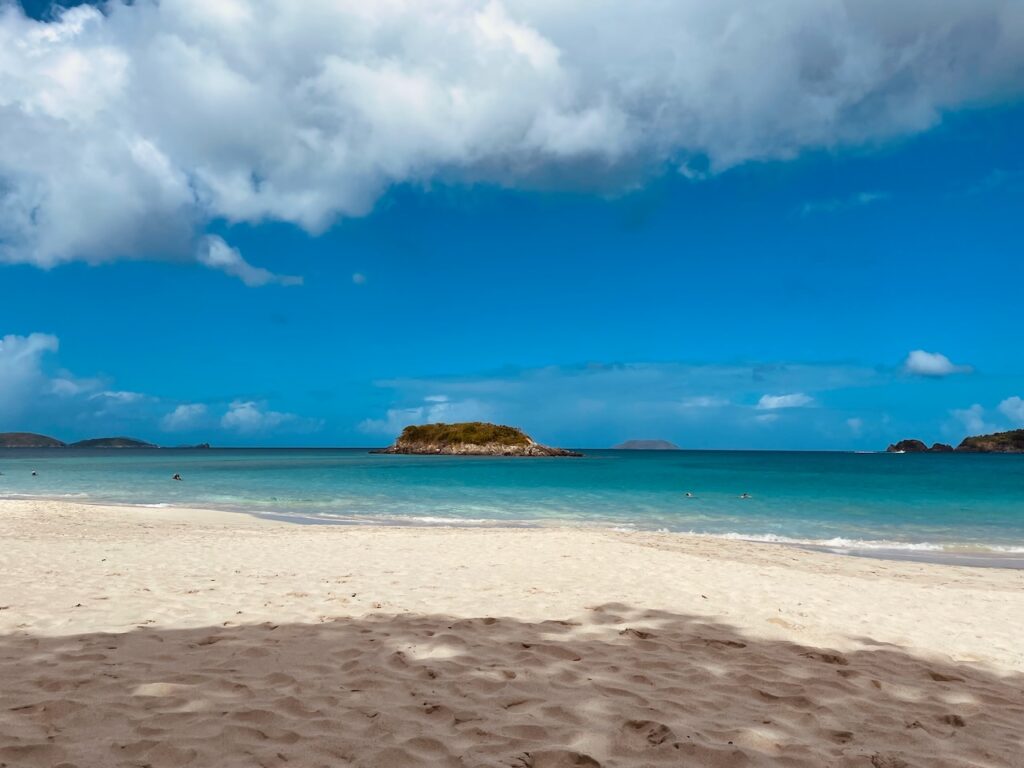
Cinnamon Bay
Resembling a beach straight out of the South Pacific, Cinnamon Bay offers soft sand and aquatic blue waters. There is not much to see snorkeling, but a great option for swimming and relaxing on the beach. Depending on the direction of the wind, the waves can get very intense. So be extra careful if you are not a strong swimmer. If it is too rough here, consider Salt Pond Beach.
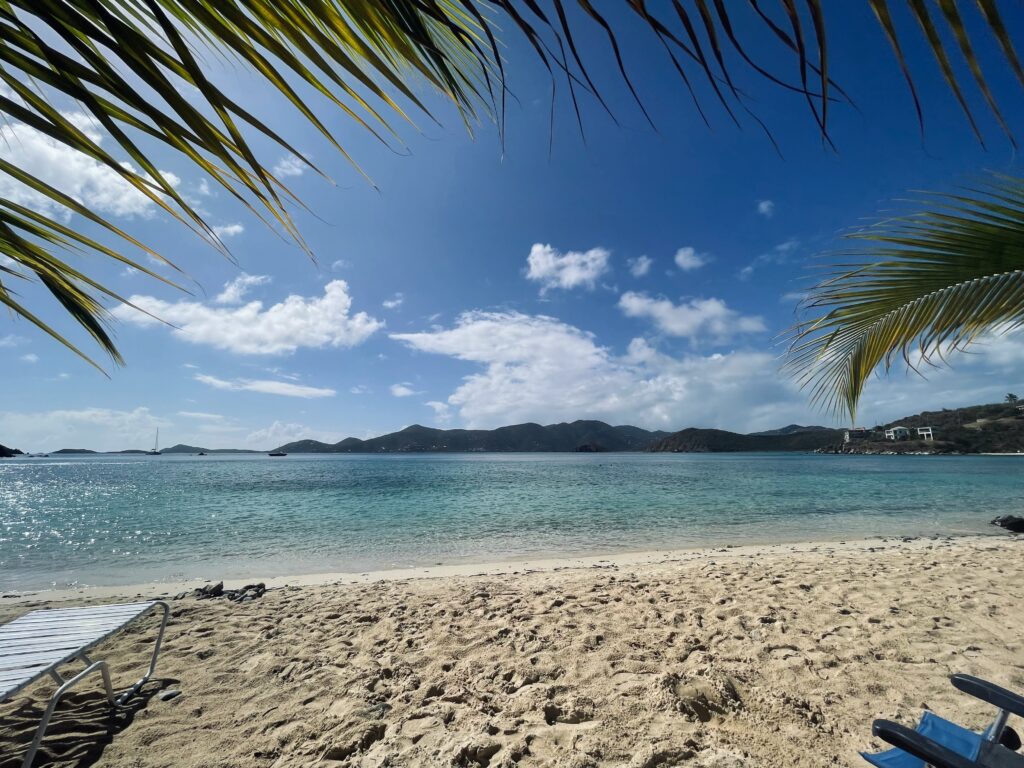
Hansen Bay Beach
Hansen Bay Beach is a private beach at the furthest end of St. John. You’ll have to donate to be able to enter the beach (donation amount up to you), but the owner has lounging beach beds along with other items like paddle boards. The owner, Thalia, is working to grow the palm trees on the beach after it got wiped out by the hurricane. Thalia mentioned we should try to snorkel out alongside the cliff for coral, which is where we spotted a small shark passing by.
The roads are steep, bumpy, and partly unpaved. So be careful driving to this beach. You will be glad you rented a Jeep for this one.
